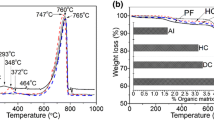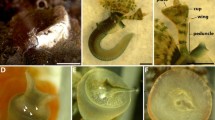Abstract
The shell penetrating mechanism of the muricid gastropod Urosalpinx cinerea follyensis Baker was examined with reference to solubilizing effects of the secretion of the accessory boring organ (ABO) on the ultrastructural organic and mineral components of the shell of the bivalve Mytilus edulis Linné. The fine structure of shell etched by the secretion was contrasted with normal shell and shell solubilized artificially by acids, a chelating agent, and enzymes as an aid in interpreting the pattern etched by the secretion. A synoptic series of scanning electron micrographs of representative regions of the normal shell of M. edulis was prepared to serve as a standard for ultrastructural interpretation of the patterns of dissolution. Intercrystalline conchiolin of the mosaicostracal, prismatic, myostracal, and nacreous strata was dissolved as readily as the periostracum by the ABO secretion. In the prismatic region, maximum depth of dissolution of intercrystalline organic matrix occurred when long axes of prisms were approximately perpendicular to the surface being dissolved. Microscopic solubilization of organic matrix noticeably preceded dissolution of mineral crystals, revealing subsurface prisms and lamellae similar in size and form to the distinctively shaped normal shell units. After solubilization of intercrystalline conchiolin, further dissolution by the ABO secretion revealed a variety of what appeared like internal structures in prisms and lamellae. The form of these subunits varied from that of platelets to nodules in prisms and from laths to nodules in lamellae. These intracrystalline patterns of dissolution probably resulted from preferential etching of (a) soluble intracrystalline conchiolin membranes or other internal aggregates of nacrin, (b) heterogeneously distributed trace and minor elements, or (c) from both. Carriker and Williams (1978) hypothesized that a combination of HCl, chelating agents, and enzymes in a hypertonic mucoid secretion released by the ABO dissolve shell during hole boring. The similarity of patterns of dissolution etched by the ABO secretion and those produced artificially by HCl and EDTA in the present study support the hypothesis that these chemicals, or chemicals similar to them, are constituents of the ABO secretion. Lactic and succinic acids and a chitinase-like enzyme were also suggested by Carriker and Williams as possible agents in shell dissolution. Alteration of the shell surface by experimental application of these, and other, chemical agents was not sufficiently comparable to that etched by the ABO secretion to support the suggestion. Preferential dissolution of shell matrix by the ABO secretion is functionally advantageous to boring gastropods because it increases the surface area of mineral crystals exposed to solubilization and facilitates removal of shell units from the surface of the borehole by the radula.
Similar content being viewed by others

Literature Cited
Alexandersson, T.: Micritization of carbonate particles: processes of precipitation and dissolution in modern shallow-marine sediments. Bull. geol. Instn Univ. Upsala (N.S. 3) 7, 201–236 (1972)
Carriker, M.R.: Excavation of boreholes by the gastropod Urosalpinx: an analysis by light and scanning electron microscopy. Am. Zool. 9, 917–933 (1969)
—: Observations on removal of spines by muricid gastropods during shell growth. Veliger 15, 69–74 (1972)
—: Ultrastructural evidence that gastropods swallow shell rasped during hole boring. Biol. Bull. mar. biol. Lab., Woods Hole 152, 325–336 (1977)
—, J.G. Schaadt and V. Peters: Analysis by slowmotion picture photography and scanning electron microscopy of radular function in Urosalpinx cinerea follyensis (Muricidae, Gastropoda) during shell penetration. Mar. Biol. 25, 63–76 (1974)
—, D.B. Scott and G.N. Martin: Demineralization mechanism of boring gastropods. Publs Am. Ass. Advmt Sci. 75, 55–89 (1963)
— and E.H. Smith: Comparative calcibiocavitology: summary and conclusions. Am. Zool. 9, 1011–1020 (1969)
— and D. Van Zandt: Predatory behavior of a shell-boring muricid gastropod. Chapter 5. In: Behavior of marine animals: current perspectives in research. Vol. 1. Invertebrates, pp. 157–244. Ed. by H.E. Winn and B.L. Olla. New York: Plenum Press 1972a
——: Regeneration of the accessory boring organ of muricid gastropods after excision. Trans. Am. microsc. Soc. 91, 455–466 (1972b)
——: Activity of the marine gastropod Urosalpinx cinerea in the absence of hibernation. Chesapeake Sci. 14, 285–288 (1973)
— and L.G. Williams: Chemical mechanism of shell penetration by Urosalpinx: an hypothesis. Malacologia 17, 142–156 (1978)
—— and D. Van Zandt: Preliminary characterization of secretion of accessory boring organ of Urosalpinx cinerea. Malacologia 17, 125–142 (1978)
Chave, K.E., K.S. Deffeyes, P.K. Weyl, R.M. Garrels and M.E. Thompson: Observations on the solubility of skeletal carbonates in aqueous solutions. Science, N.Y. 137, 33–34 (1962)
Crenshaw, M.: The soluble matrix from Mercenaria mercenaria shell. Biomineraliz. Res. Rep. 6, 6–11 (1972)
Day, J.A.: Feeding of the cymatiid gastropod Argobuccinum argus in relation to the structure of the proboscis and secretion of the proboscis gland. Am. Zool. 9, 909–916 (1969)
Dodd, J.R.: Environmental control of strontium and magnesium in Mytilus. Geochim. cosmochim. Acta 29, 385–398 (1965)
—: Magnesium and strontium in calcareous skeletons: a review. J. Paleont. 41, 1313–1329 (1967)
Dunachie, J.F.: The periostracum of Mytilus edulis. Trans. R. Soc. Edinb. 65, 383–410 (1962–1963)
Frazier, J.M.: The dynamics of metals in the American oyster, Crassostrea virginica, 2. Environmental effects. Chesapeake Sci. 17, 188–197 (1976)
Fretter, V. and A. Graham: British prosobranch molluscs: their functional anatomy and ecology, 755 pp. London: The Ray Society 1962
Göffinet, G.: Etude au microscope electronique de structures organisees des constituants de la conchioline de nacre du Nautilus macromphalus Sowerby. Comp. Biochem. Physiol. 29, 835–839 (1969)
Grégoire, C.: Topography of the organic components of mother-of-pearl. J. biophys. biochem. Cytol. 3, 797–808 (1957)
—: Structure of the molluscan shell. In: Chemical zoology, pp 45–102. Ed. by M. Florkin and B.T. Scheer. New York: Academic Press 1972a
—: Experimental alteration of the Nautilus shell by factors involved in diagenesis and in metamorphism. Part 3. Thermal and hydrothermal changes in the organic and mineral components of the mural mother-of-pearl. Bull. Inst. r. Sci. nat. Belg. 48, 1–85 (1972b)
Kobayashi, I.: Internal shell microstructures of recent bivalve molluscs. Sci. Rep. Niigata Univ. (Ser. E, Geol. Mineral.) 2, 27–50 (1971)
Meenakshi, V.R., P.L. Blackwelder and K.M. Wilbur: An ultrastructural study of shell regeneration in Mytilus edulis (Mollusca: Bivalvia). J. Zool., Lond. 171, 475–484 (1973)
—, P.E. Hare, N. Watabe and K.M. Wilbur: The chemical composition of the periostracum of the molluscan shell. Comp. Biochem. Physiol. 29, 611–620 (1969)
—— and K.M. Wilbur: Amino acids of the organic matrix of neogastropod shells. Comp. Biochem. Physiol. 40B, 1037–1043 (1971)
Milliman, J.D.: Recent sedimentary carbonates. Part 1. Marine carbonates, 375 pp. Berlin: Springer-Verlag 1974
Moberly, R.: Composition of magnesian calcites of algae and pelecypods by electron microprobe analysis. Sedimentology 11, 61–82 (1968)
Murphy, A.P., G.L. McNeil and R.J. Neal: Ultramicrotome for hard tissue. Rev. Scient. Instrum. 38, 921–924 (1967)
Mutvei, H.: On the micro- and ultrastructure of the conchiolin in the nacreous layer of some recent and fossil molluscs. Stockh. Contr. Geol. 20, 1–17 (1969)
—: Ultrastructure of the mineral and organic components of molluscan nacreous layers. Biomineraliz. Res. Rep. 2, 48–72 (1970)
—: The nacreous layer in Mytilus, Nucula, and Unio (Bivalvia). Calc. Tissue Res. 24, 11–18 (1977)
Nichol, T., G. Judd and G.S. Ansell: Effects of EDTA and HCl treatments on enamel fracture surfaces. In: Scanning electron microscopy 1971, pp 353–360. Ed. by O. Johari. Chicago: Illinois Institute of Technology, Research Institute 1971
Poole, D.F.G. and N.W. Johnson: The effects of different demineralizing agents on human enamel surfaces studied by scanning electron microscopy. Archs oral Biol. 12, 1621–1634 (1967)
Romanini, M.G.: Osservazioni sulla ialuronidase delle ghiandole salivari anteriori e posteriori degli Octopodi. Pubbl. Staz. zool. Napoli 23, 251–270 (1952)
Suess, E. and D. Fütterer: Aragonitic ooids: experimental precipitation from seawater in the presence of humic acid. Sedimentology 19, 129–139 (1972)
Taylor, J.D., W.J. Kennedy and A. Hall: The shell structure and mineralogy of the Bivalvia. Introduction. Nuculacea-Trigonacea. Bull. Br. Mus. nat. Hist. (Ser. D, Zool., Suppl.) 3, 1–125 (1969)
Towe, K.M.: Invertebrate shell structure and the organic matrix concept. Biomineraliz. Res. Rep. 4, 1–14 (1972)
— and G.H. Hamilton: Ultramicrotome-induced deformation artifacts in densely calcified material. J. Ultrastruct. Res. 22, 274–281 (1968)
— and G.R. Thompson: The structure of some bivalve shell carbonates prepared by ion-beam thinning. Calc. Tissue Res. 10, 38–48 (1972)
Travis, D.F.: The structure and organization of, and the relationship between, the inorganic crystals and the organic matrix of the prismatic region of Mytilus edulis. J. Ultrastruct. Res. 23, 183–215 (1968a)
—: Comparative ultrastructure and organization of inorganic crystals and organic matrices of mineralized tissues. Publs Am. Ass. Advmt Sci. 89, 237–297 (1968b)
—, C.J. Francois, L.C. Bonar and M.J. Glimcher: Comparative studies of the organic matrices of invertebrate mineralized tissues. J. Ultrastruct. Res. 18, 519–550 (1967)
— and M. Gonsalves: Comparative ultrastructure and organization of the prismatic region of two bivalves and its possible relation to the chemical mechanism of boring. Am. Zool. 9, 653–661 (1969)
Watabe, N.: Studies on shell formation. XI. Crystal-matrix relationships in the inner layers of mollusk shells. J. Ultrastruct. Res. 12, 351–370 (1965)
Wilbur, K.M.: Shell formation in mollusks. In: Chemical zoology, pp 103–145. Ed. by M. Florkin and B.T. Scheer. New York: Academic Press 1972
Wise, S.W.: Study of molluscan shell ultrastructures. In: Scanning electron microscopy 1969, pp 205–216. Ed. by O. Johari, Chicago: Illinois Institute of Technology, Research Institute 1969
— and W.W. Hay: Scanning electron microscopy of molluscan shell ultrastructures. 1. Techniques for polished and etched sections. Trans. Am. microsc. Soc. 87, 411–418 (1968)
Zottoli, R.A. and M.R. Carriker: Burrow morphology, tube formation, and microarchitecture of shell dissolution by the spionid polychaete Polydora websteri. Mar. Biol. 27, 307–316 (1974)
Author information
Authors and Affiliations
Additional information
Communicated by M.R. Tripp, Newark
Rights and permissions
About this article
Cite this article
Carriker, M.R. Ultrastructural analysis of dissolution of shell of the bivalve Mytilus edulis by the accessory boring organ of the gastropod Urosalpinx cinerea . Mar. Biol. 48, 105–134 (1978). https://doi.org/10.1007/BF00395012
Accepted:
Issue Date:
DOI: https://doi.org/10.1007/BF00395012



